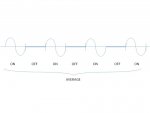ArchieMedes
Member
Hi All,
I would like to ask about the principle on how a clamp ammeter reads the current. This is not about EMF / induction that is sensed by the ammeter. This is about the current digital reading shown by the ammeter.
I understand that there are some ammeter which uses averaging and RMS value of the current flowing. I am guessing this is based on the assumption that the AC current it is reading is a pure/perfect sinusoidal waveform with a frequency of, say, 50 or 60 Hz. So, I am guessing, it will just take ONE cycle of the AC current, computes its average or RMS value and show this value in the digital display. IS THIS THE CASE???
Now, if I have an AC current continuously flowing being measured by the clamp ammeter and it has perfect sinusoidal waveforms (no distortion whatsoever) BUT the current cycles are turning 1 cycle ON and 1 cycle OFF of the usual 50 or 60 Hz (in this case it is half or 25 or 30 Hz)...Will it still SAMPLE ONE cycle and measure its average or RMS value? In this case, it will be the same reading as the former''s case reading BUT I believe this is NOT ACCURATE anymore as the current reading SHOULD be effectively only HALF of the former's reading because it is turning ON and OFF at 1 cycle each.
Are there any clamp meters which can read the average value NOT of the single cycle of the AC waveform but the average of the effective current, say, for 1 second timeframe???
Please enlighten me on this. Sorry for the very long narration. Just want to be clear and concise on this question. Thanks in advance!
Archie
I would like to ask about the principle on how a clamp ammeter reads the current. This is not about EMF / induction that is sensed by the ammeter. This is about the current digital reading shown by the ammeter.
I understand that there are some ammeter which uses averaging and RMS value of the current flowing. I am guessing this is based on the assumption that the AC current it is reading is a pure/perfect sinusoidal waveform with a frequency of, say, 50 or 60 Hz. So, I am guessing, it will just take ONE cycle of the AC current, computes its average or RMS value and show this value in the digital display. IS THIS THE CASE???
Now, if I have an AC current continuously flowing being measured by the clamp ammeter and it has perfect sinusoidal waveforms (no distortion whatsoever) BUT the current cycles are turning 1 cycle ON and 1 cycle OFF of the usual 50 or 60 Hz (in this case it is half or 25 or 30 Hz)...Will it still SAMPLE ONE cycle and measure its average or RMS value? In this case, it will be the same reading as the former''s case reading BUT I believe this is NOT ACCURATE anymore as the current reading SHOULD be effectively only HALF of the former's reading because it is turning ON and OFF at 1 cycle each.
Are there any clamp meters which can read the average value NOT of the single cycle of the AC waveform but the average of the effective current, say, for 1 second timeframe???
Please enlighten me on this. Sorry for the very long narration. Just want to be clear and concise on this question. Thanks in advance!
Archie

